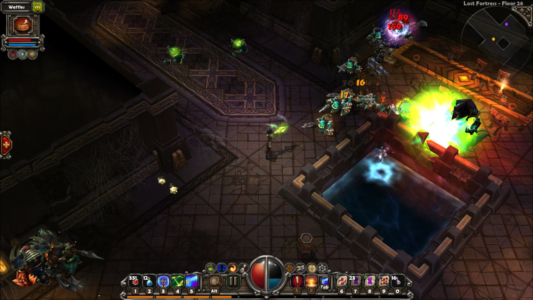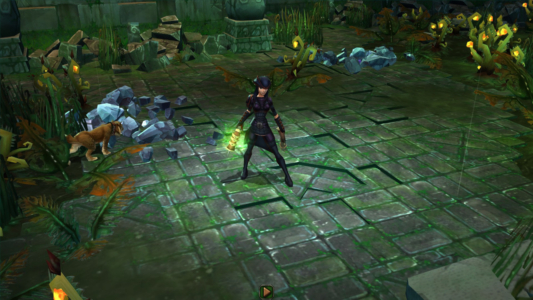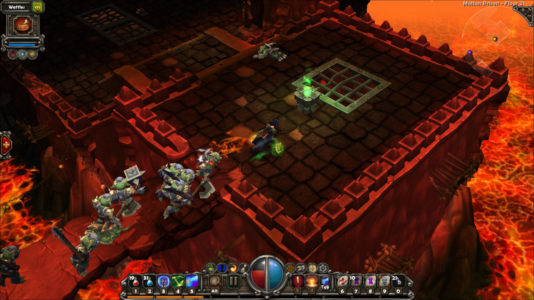
Torchlight
Written by: Stoo
Date posted: February 10, 2023
- Genre: RPG
- Developed by: Runic Games
- Published by: Perfect World
- Year released: 2009
- Our score: 8
Last year, upon concluding my look at Dungeon Siege 2, I decided it was probably my favourite of the Diablo-style action-RPGs from the 2000s. Yet I only rated it seven out of ten. Not a bad score, or even an average one. Yet not quite outstanding either, so you might be a little surprised to see it given to the supposed “top of the class”.
I suppose that reflects the odd state of ambivalence I’ve reached, regarding these games. With their simple combat mechanics they’re easy to pick up and addictive for a while; that’s why I was playing DS2 in the first place and not something more complex and beardy like an Ultima or a Wizardry. Yet after a while they inevitably become repetitive and grindy. Run through maps, kill endless swarms monsters by firing off the same few abilities over and over, gather loot. Now do it all again on the next map with slightly tougher monsters. I find myself wondering if this sort of game is genuinely enjoyable. Or have I just become conditioned to perform rote, mindless actions in the hope of minor rewards like a slightly shinier sword or a 3% better version of a magic spell.
So today I’m happy to report I’ve found a new favourite of the decade, and one I can honestly say had me hooked until the end. Today we’re looking at Torchlight. Released in 2009 (so narrowly making it into the category), it was developed by from Runic Games. The team certainly had some expertise aboard: it included the Schaefar brothers who led development of the first two Diablo games..
So then it’s fitting that the premise has a lot in common with resembles the original Diablo. The small town of Torchlight sits above a series of tunnels where a mysterious, magical ore called Ember is mined. This substance can be used to create amazing enchanted artefacts, and so is highly valuable. Unfortunately it also corrupts living creatures nearby be they beasts or people. In fact, its creeping influence may have lead to the end of earlier civilizations, whose ruins lie below the mines.
Three heroes arrive at Torchlight: the Destroyer, Vanquisher and Alchemist. Summoned by a sage named Syl, their mission is to find her mentor, a man of great learning called Olrac. Seems he delved within the mines on a quest to discover the true nature of Ember, but then he never returned. I’m sure he’s fine…
Brief preamble over, the game will be immediately familiar to anyone who’s played action-RPGs. Run around fighting monsters by left clicking to make a basic weapon swing, or right clicking (or using hotkeys) to use special attacks that consume your reserves of manna. Many, many mouse clicks will be required to make your way through each level of the dungeon.
You’ll be on the constant lookout for gear that bestows ever-better boosts to your attributes – a sword with greater critical hit chance, a special hat to boost agility and so on. Also as you slay monsters you’ll also be gathering experience points for those all-important level ups. When this occurs you grant a point to spend on talents, choosing from three unique sets for each hero. You can use that point to pick a new ability (big exploding shot, whirling strike, etc) or a more passive bonus (boost to swords and maces). Alternatively you can boost an existing talent further. True skill at this game then only partially lies in all the frenzied clicking. To maximise your character’s killing power you should also look for optimal sets of talents, and then match them with appropriate gear that boosts relevant stats.
Sounds like there’s nothing revolutionary here, right? True, but there are many small new ideas along with expert refinements and tuning of the core arpg mechanics. I could start with the character pets – Dungeon Siege had something similar but these are more useful (and lovable). They help you fighting, and also can run loot back to town to sell while you remain in the dungeon. They can be either cat or a dog and you can go ahead and give them a name like “Mr Waffles”. You can even throw them health potions, and give them their own magic artfecacts.
Also, character building has more options than you might expect – and I don’t just mean choosing between ice and fire magic. The three heroes might look a lot like basic archetypes: Destroyer is Warrior guy, Vanquisher is Ranged Weapons Lady and Alchemist is Magic Guy, straight out of Diablo. However one talent set of the Alchemist turns them into a close quarters fighter, alternating weapon strikes with powerful short-range shockwaves. The Destroyer conversely can be built into a mystical shamanic spellcaster. The Vanquisher meanwhile can be based around magical traps, with the choice of weapon almost a secondary matter.
New talent choices become accessible based on level, but they’re not in a “tree” arrangement, eg not contingent on previous choices. This means more freedom to pick something new upon level up, compared to some other arpgs. Even if focused on one tab you can hop over to another for something useful; my Vanquisher was mostly focused on shooting, but I grabbed a handy skill in another tab that knocks nearby enemies back (so you can make some space and retreat).
There’s also a wholly separate set of magic spells that are available to all three classes. It’s a bit like the spell system from the original Diablo, except no character is innately any better or worse at them. On top of that there are talents, also universal across the classes, that enhance various categories of these spells. I realise this this already sounds like unwanted complication, but actually it means another layer of customisability.
So back on my Vanquisher, I had her summoning a little squad of skeletons and zombies to follow her around. I’d send them into battle then hang back using the explosive shot talent, which has both a long range and significant a blast radius. So basically I’d built some sort of mix of necromancer and mobile artillery, and you have to admit that doesn’t sound like something out of a typical D&D rulebook.
There are a few major boss fights throughout the game, at key points in the story. Also each level carries a few larger and more powerful versions of regular monsters, randomly generated, just to keep you on your toes. Killing these bigger enemies generates you “fame”, as you rise from nobody to epic champion. This basically serves as a parallel set of character levels; each new title you gain grants another skill point. The additional source of points means that, while they still slow down at high levels, you’re never left waiting an excessive amount of time. (I recall Diablo 2 getting far too stingy with them towards the end).
Would you like more extra features? Here’s one: additional side-dungeons activated by talking to a quest-giver, or buying artifacts from a vendor. These make a for a change of scenery, or a chance at more named enemies for loot and fame. Although they always seemed to be at higher level than my current place in the main dungeon, which seems a bit odd. I’d have thought a better use would be slightly easier enemies to build up experience, if you’re getting battered in the main sequence.
I should finish by commenting on the presentation of the game, since I found that played a big part in Torchlight’s appeal. The dungeons are dark and ominous, but there’s still colour to be found and the game is never drab. The initial mines are probably the greyest part; past that you start uncovering all those lost ruins of civillisations past. Past the initial mines you venture through grand halls of long-dead dwarvern kingdoms. Then there are half-drowned ruins, overgrown with lush green vegetation. The characters meanwhile have a bold, slightly exaggerated style; the Destroyer’s shoulders are almost as wide as he is tall while the Alchemist is quite steampunk in his goggles and protective leather coat. It occured to me that if you were to make a Diablo style game, but base it on Warcraft (eg Blizzard’s other fantasy franchise), you wouldn’t end up a million miles from this.
Overall then Torchlight remains action-RPG business at usual, yet it shook me out of my malaise regarding the genre. I hope that I’ve adequately explained everything that it gets right. Thanks to all those tweaks and adjustments that Runic applied to the formula, it remains consistently engaging instead of becoming a grinding chore. Upon reaching my precious free hour or two each evening (work done, dishes washed, young daughter in bed), I was ready and eager to spend that time fighting my way through another level or two of the dungeon.
I could think of room for improvement for sure. The story is fairly thin, and characters aren’t developed much. Outside of the main quest, side missions are the same repeated tasks (get a piece of special ember, kill some named monster) reporting back to the same two guys. Okay a lot of gamers aren’t here for detailed narrative, but all the background lore works in the favour of the Diablo series. Also, it can’t hurt to have a bit of attachment to the people you encounter in your quest.
There’s also no multiplayer. I don’t care about that myself and don’t factor it into my own conclusions. Still I know some folks like to team up to tackle challenges together, and might be hoping servers are still up for a game of this vintage. So I may as well let yo know, to avoid disappointment.
Anyway, I’d say this warrants an eight, the highest score I’ve yet given an aRPG. Not a lofty nine? Well, maybe I still reserve top marks for immersive sims, because I’m still a dreadful bore like that. Or perhaps I’m mindful that there’s a Torchlight 2 which would maybe fall in our scope (released 2012) and could be even better. Whatever, I’ve never liked numerical scores anyway. Just give Torchlight a try.





 Posts
Posts